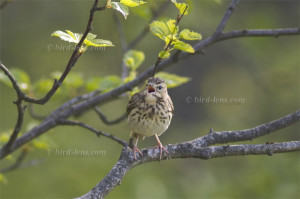 A remembrance of a song, beautiful and both familiar and strange. It took a while until I got the clue. It was a Tree Pipit (Anthus trivialis) singing in a woodland in the heath on sunday. Singing now south of Berlin, seen 20 days ago in Cameroon. There the subspecies trivialis was still fairly common near the Ngaoundaba Ranch on the Adamawa Plateau of middle Cameroon in the beginning of April. Other migrant WP-birds were Eurasian Hoopoe (Upupa epops), Great Reed-Warbler (Acrocephalus arundinaceus), Blackcap (Sylvia atricapilla) and many Whinchats (Saxicola rubetra).
A remembrance of a song, beautiful and both familiar and strange. It took a while until I got the clue. It was a Tree Pipit (Anthus trivialis) singing in a woodland in the heath on sunday. Singing now south of Berlin, seen 20 days ago in Cameroon. There the subspecies trivialis was still fairly common near the Ngaoundaba Ranch on the Adamawa Plateau of middle Cameroon in the beginning of April. Other migrant WP-birds were Eurasian Hoopoe (Upupa epops), Great Reed-Warbler (Acrocephalus arundinaceus), Blackcap (Sylvia atricapilla) and many Whinchats (Saxicola rubetra).
The Tree Pipit is a small passerine bird which breeds across most of Europe. It is an nondescript species, similar to the Meadow Pipit (Anthus pratensis). The Tree Pipit is brown with streakings above and has black markings on a white belly and buff breast below. It can be distinguished from the slightly smaller Meadow Pipit by its heavier bill and greater contrast between its buff breast and white belly. Tree pipits more readily perch in trees in comparison to its near relative.
The Tree Pipit breeds across most of Europe and temperate western and central Asia in a variety of habitats. It is a long-distance migrant moving in winter to Africa and southern Asia. Tree Pipits normally migrate as far as to the miombo highlands in Eastern Zimbabwe. They are only vagrants to parts of South Africa. Tree Pipits is not reported of being breeding in sub-Saharan wintering grounds.
The Tree Pipit’s song flight is unmistakable. The bird rises a short distance up from a tree and then parachutes down on stiff wings. The call has a strong sounding.
To cope with the growing demand for top shots of the rarer species of the Palearctic Bird-Lens is keen to enrich the range of pictures of birds you can find in the western palearctic. Beside the image above you can find a nice selection of birds in the gallery or in the “Pictures Shop” very soon. Just give a message, if Bird-Lens could serve you with an image needed before the new pictures are online.